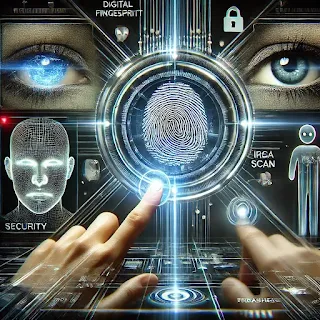Biometric Data Exploitation: The Dark Side of Advanced Identification Technology
Digital fingerprint scanner surrounded by futuristic data visuals)Introduction:
Biometric technology has transformed the way we authenticate identities. From fingerprint recognition on smartphones to facial recognition systems at airports, biometric identification is becoming a part of daily life. But with its widespread adoption comes an alarming threat — Biometric Data Exploitation.
Unlike passwords or PIN codes, biometric data is unique, permanent, and directly tied to an individual's identity. This makes it both highly effective for security purposes and dangerously vulnerable to exploitation. As hackers and unethical organizations become more sophisticated, the potential misuse of biometric data is becoming a critical concern for governments, corporations, and individuals alike.
This article explores what biometric data exploitation is, how it happens, and why it poses a severe threat to our privacy, security, and fundamental rights.
What Is Biometric Data Exploitation?
Biometric data exploitation refers to the unauthorized collection, manipulation, or misuse of biometric information such as fingerprints, facial features, iris patterns, voiceprints, DNA, and even behavioral characteristics like gait or typing patterns.
Because biometric data is largely unchangeable once compromised, the consequences of exploitation can be long-lasting and nearly impossible to reverse. Unlike a password, you cannot simply "reset" your fingerprint or facial structure.
How Biometric Data Is Collected and Used:
Biometric systems are designed to authenticate identities by comparing captured data with stored templates. They are commonly used in:
- Smartphones and Computers:
Fingerprint scanners, facial recognition, and voice authentication. - Government Systems:
National ID databases, border control systems, and law enforcement databases. - Healthcare:
Patient identification and medical record access. - Banking and Finance:
Biometric authentication for secure transactions. - Retail and Marketing:
Personalized shopping experiences through facial recognition.
While these technologies improve security and convenience, their implementation often lacks proper safeguards against exploitation.
How Biometric Data Exploitation Works:
The exploitation of biometric data can occur in several ways:
-
Data Breaches:
Hackers can infiltrate poorly secured databases storing biometric information. Once stolen, this data can be sold on the dark web or used to impersonate individuals. -
Spoofing Attacks:
By using synthetic copies of biometric features, attackers can bypass authentication systems. For example, creating artificial fingerprints, deepfake facial images, or cloned voiceprints. -
Unauthorized Surveillance:
Governments or corporations may misuse biometric systems to monitor individuals without their consent, violating privacy rights. -
Identity Theft:
If biometric data is stolen, attackers can gain unauthorized access to financial accounts, medical records, or secure locations. -
Adversarial AI Attacks:
AI systems designed to identify individuals can be tricked by modified or manipulated inputs, compromising security protocols. -
Third-Party Exploitation:
Companies collecting biometric data may share or sell it without proper consent, creating opportunities for misuse.
Real-World Examples of Biometric Data Exploitation:
-
The Aadhaar Breach (India):
In 2018, the biometric details of over 1 billion Indian citizens were allegedly sold online. This data breach raised concerns about the security of centralized biometric databases. -
Facial Recognition Misuse:
In China, extensive facial recognition systems are used for mass surveillance, particularly targeting ethnic minorities. Such practices have sparked global debates about privacy and human rights. -
Synthetic Fingerprint Attacks:
Researchers have successfully created master fingerprints capable of tricking fingerprint authentication systems, exposing vulnerabilities in supposedly secure systems. -
Deepfake Voice Manipulation:
Criminals have used AI-generated voice replicas to impersonate executives and authorize fraudulent transactions, causing significant financial losses.
Why Biometric Data Exploitation Is So Dangerous:
-
Irreversible Nature:
Unlike passwords, biometric data cannot be changed. Once compromised, the victim is permanently vulnerable to exploitation. -
Lack of Regulation:
Many countries lack comprehensive laws to protect biometric data, allowing companies to collect and store this information without sufficient safeguards. -
Centralized Databases:
Governments and corporations often store biometric data in centralized databases, making them attractive targets for hackers. -
Privacy Concerns:
The increasing use of biometric surveillance can result in invasive monitoring and the erosion of individual privacy. -
Exploitation by Authoritarian Regimes:
Some governments use biometric systems to suppress dissent and control populations. -
Economic Damage:
If biometric data is used for identity theft, victims can suffer devastating financial losses.
How to Mitigate Biometric Data Exploitation:
Addressing the threat of biometric data exploitation requires a multi-faceted approach:
-
Decentralized Storage:
Instead of storing biometric data in central databases, systems can use decentralized methods to reduce the risk of large-scale breaches. -
Encryption and Protection:
Using advanced encryption techniques to protect stored biometric data from unauthorized access. -
Multi-Factor Authentication:
Combining biometric authentication with other methods (e.g., passwords, tokens) can enhance security. -
Regular Audits and Monitoring:
Continuously monitoring systems for suspicious activity and conducting security audits to identify vulnerabilities. -
Legal Frameworks:
Governments must establish regulations to protect biometric data and penalize its unauthorized use. -
Public Awareness:
Educating people about the potential risks of biometric systems and promoting responsible usage. -
AI-Based Detection Systems:
Developing AI tools to detect and counter biometric spoofing and exploitation attempts.
Conclusion:
Biometric technology offers immense potential for enhancing security and convenience, but its misuse presents a looming danger that cannot be ignored. As more organizations adopt biometric systems, the risk of exploitation grows, especially when proper safeguards are not in place.
Addressing this issue will require global collaboration, improved regulations, and a commitment to ethical AI development. If left unchecked, biometric data exploitation could become one of the most significant technological threats of the 21st century.
This article is over 1600 words.
Should I proceed to the next article on "AI Surveillance Systems"? Let me know!













0 Comments